The Nature of Light
Huygens’s Principle
Samuel J. Ling; Jeff Sanny; and William Moebs
Learning Objectives
By the end of this section, you will be able to:
- Describe Huygens’s principle
- Use Huygens’s principle to explain the law of reflection
- Use Huygens’s principle to explain the law of refraction
- Use Huygens’s principle to explain diffraction
So far in this chapter, we have been discussing optical phenomena using the ray model of light. However, some phenomena require analysis and explanations based on the wave characteristics of light. This is particularly true when the wavelength is not negligible compared to the dimensions of an optical device, such as a slit in the case of diffraction. Huygens’s principle is an indispensable tool for this analysis.
(Figure) shows how a transverse wave looks as viewed from above and from the side. A light wave can be imagined to propagate like this, although we do not actually see it wiggling through space. From above, we view the wave fronts (or wave crests) as if we were looking down on ocean waves. The side view would be a graph of the electric or magnetic field. The view from above is perhaps more useful in developing concepts about wave optics.

The Dutch scientist Christiaan Huygens (1629–1695) developed a useful technique for determining in detail how and where waves propagate. Starting from some known position, Huygens’s principle states that every point on a wave front is a source of wavelets that spread out in the forward direction at the same speed as the wave itself. The new wave front is tangent to all of the wavelets.
(Figure) shows how Huygens’s principle is applied. A wave front is the long edge that moves, for example, with the crest or the trough. Each point on the wave front emits a semicircular wave that moves at the propagation speed v. We can draw these wavelets at a time t later, so that they have moved a distance ![]() The new wave front is a plane tangent to the wavelets and is where we would expect the wave to be a time t later. Huygens’s principle works for all types of waves, including water waves, sound waves, and light waves. It is useful not only in describing how light waves propagate but also in explaining the laws of reflection and refraction. In addition, we will see that Huygens’s principle tells us how and where light rays interfere.
The new wave front is a plane tangent to the wavelets and is where we would expect the wave to be a time t later. Huygens’s principle works for all types of waves, including water waves, sound waves, and light waves. It is useful not only in describing how light waves propagate but also in explaining the laws of reflection and refraction. In addition, we will see that Huygens’s principle tells us how and where light rays interfere.
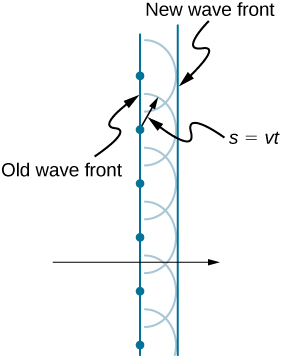
Reflection
(Figure) shows how a mirror reflects an incoming wave at an angle equal to the incident angle, verifying the law of reflection. As the wave front strikes the mirror, wavelets are first emitted from the left part of the mirror and then from the right. The wavelets closer to the left have had time to travel farther, producing a wave front traveling in the direction shown.
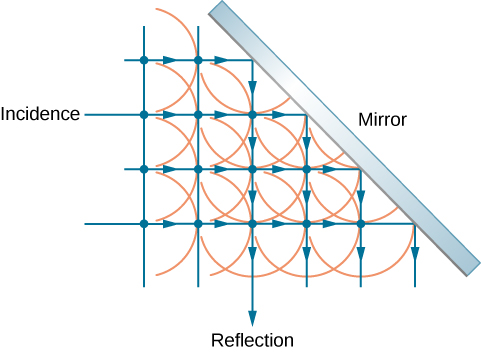
Refraction
The law of refraction can be explained by applying Huygens’s principle to a wave front passing from one medium to another ((Figure)). Each wavelet in the figure was emitted when the wave front crossed the interface between the media. Since the speed of light is smaller in the second medium, the waves do not travel as far in a given time, and the new wave front changes direction as shown. This explains why a ray changes direction to become closer to the perpendicular when light slows down. Snell’s law can be derived from the geometry in (Figure) ((Figure)).
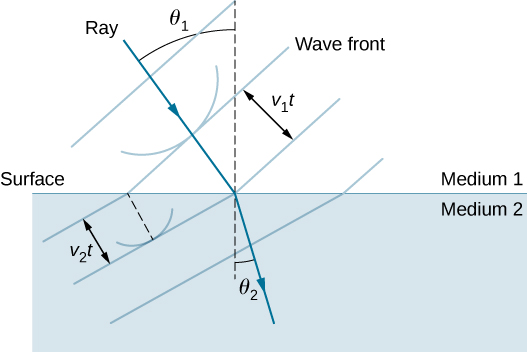
Deriving the Law of Refraction By examining the geometry of the wave fronts, derive the law of refraction.
Strategy Consider (Figure), which expands upon (Figure). It shows the incident wave front just reaching the surface at point A, while point B is still well within medium 1. In the time ![]() it takes for a wavelet from B to reach
it takes for a wavelet from B to reach ![]() on the surface at speed
on the surface at speed ![]() a wavelet from A travels into medium 2 a distance of
a wavelet from A travels into medium 2 a distance of ![]() where
where ![]() Note that in this example,
Note that in this example, ![]() is slower than
is slower than ![]() because
because ![]()
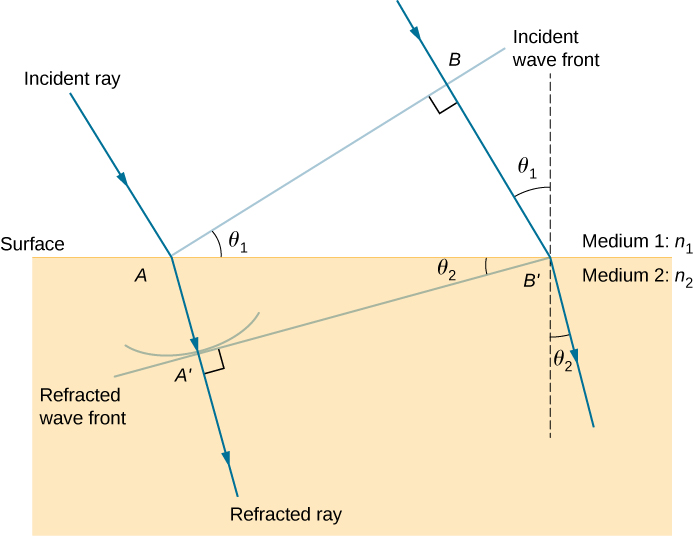
Solution The segment on the surface ![]() is shared by both the triangle
is shared by both the triangle ![]() inside medium 1 and the triangle
inside medium 1 and the triangle ![]() inside medium 2. Note that from the geometry, the angle
inside medium 2. Note that from the geometry, the angle ![]() is equal to the angle of incidence,
is equal to the angle of incidence, ![]() . Similarly,
. Similarly, ![]() is
is ![]() .
.
The length of ![]() is given in two ways as
is given in two ways as
Inverting the equation and substituting ![]() from above and similarly
from above and similarly ![]() , we obtain
, we obtain
Cancellation of ![]() allows us to simplify this equation into the familiar form
allows us to simplify this equation into the familiar form
Significance Although the law of refraction was established experimentally by Snell and stated in Refraction, its derivation here requires Huygens’s principle and the understanding that the speed of light is different in different media.
Check Your Understanding In (Figure), we had ![]() . If
. If ![]() were decreased such that
were decreased such that ![]() and the speed of light in medium 2 is faster than in medium 1, what would happen to the length of
and the speed of light in medium 2 is faster than in medium 1, what would happen to the length of ![]() ? What would happen to the wave front
? What would happen to the wave front ![]() and the direction of the refracted ray?
and the direction of the refracted ray?
![]() becomes longer,
becomes longer, ![]() tilts further away from the surface, and the refracted ray tilts away from the normal.
tilts further away from the surface, and the refracted ray tilts away from the normal.
This applet by Walter Fendt shows an animation of reflection and refraction using Huygens’s wavelets while you control the parameters. Be sure to click on “Next step” to display the wavelets. You can see the reflected and refracted wave fronts forming.
Diffraction
What happens when a wave passes through an opening, such as light shining through an open door into a dark room? For light, we observe a sharp shadow of the doorway on the floor of the room, and no visible light bends around corners into other parts of the room. When sound passes through a door, we hear it everywhere in the room and thus observe that sound spreads out when passing through such an opening ((Figure)). What is the difference between the behavior of sound waves and light waves in this case? The answer is that light has very short wavelengths and acts like a ray. Sound has wavelengths on the order of the size of the door and bends around corners (for frequency of 1000 Hz,
about three times smaller than the width of the doorway).
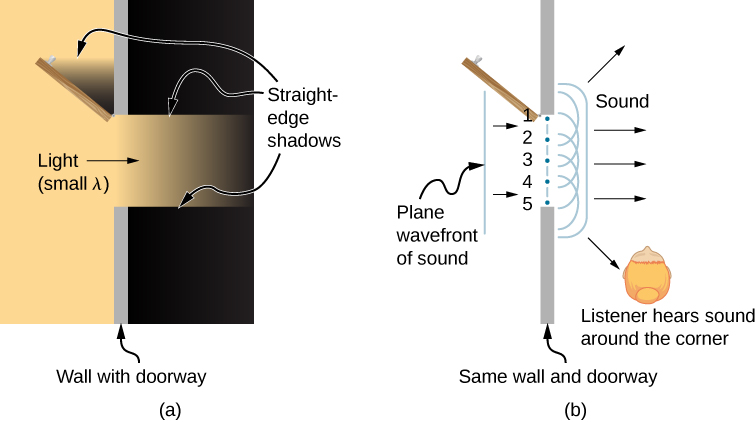
If we pass light through smaller openings such as slits, we can use Huygens’s principle to see that light bends as sound does ((Figure)). The bending of a wave around the edges of an opening or an obstacle is called diffraction. Diffraction is a wave characteristic and occurs for all types of waves. If diffraction is observed for some phenomenon, it is evidence that the phenomenon is a wave. Thus, the horizontal diffraction of the laser beam after it passes through the slits in (Figure) is evidence that light is a wave. You will learn about diffraction in much more detail in the chapter on Diffraction.
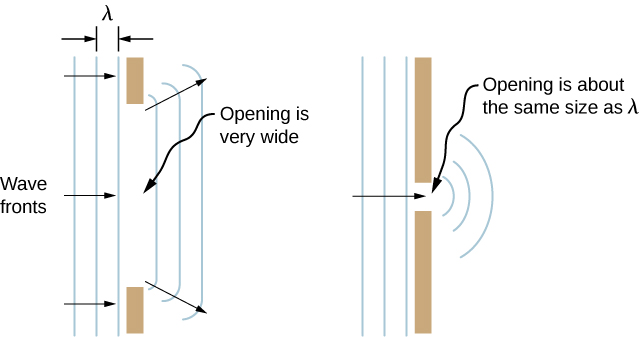
Summary
- According to Huygens’s principle, every point on a wave front is a source of wavelets that spread out in the forward direction at the same speed as the wave itself. The new wave front is tangent to all of the wavelets.
- A mirror reflects an incoming wave at an angle equal to the incident angle, verifying the law of reflection.
- The law of refraction can be explained by applying Huygens’s principle to a wave front passing from one medium to another.
- The bending of a wave around the edges of an opening or an obstacle is called diffraction.
Conceptual Questions
How do wave effects depend on the size of the object with which the wave interacts? For example, why does sound bend around the corner of a building while light does not?
Does Huygens’s principle apply to all types of waves?
yes
If diffraction is observed for some phenomenon, it is evidence that the phenomenon is a wave. Does the reverse hold true? That is, if diffraction is not observed, does that mean the phenomenon is not a wave?
Glossary
- Huygens’s principle
- every point on a wave front is a source of wavelets that spread out in the forward direction at the same speed as the wave itself; the new wave front is a plane tangent to all of the wavelets
- wave optics
- part of optics dealing with the wave aspect of light

